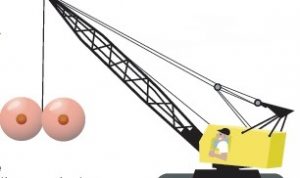Breast Blog
World Record Holding Plastic Surgeon Remains Top Cosmetic Breast Surgeon in Philadelphia
Philadelphia, PA – Dr. Ted Eisenberg is the first and only surgeon in the Philadelphia region to dedicate his practice entirely to cosmetic breast surgery. After performing more than 7,000 breast augmentation surgery procedures in his lifetime, Dr. Eisenberg has become recognized as a leading authority in his industry.
Despite his practice’s record-breaking procedures, Dr. Eisenberg attributes his success to his caring and knowledgeable staff. He promises that women will leave his office with accurate and honest information, happy that they took time to get their questions answered.
As a result, the practice has benefited from years of word-of-mouth advertising.
Silicone gel implants are recommended by the FDA and the manufacturers for women 22 and older. Saline implants are available to women ages 18 and up. Although the majority of Dr. Eisenberg’s patients fall in the latter range, young women who have not developed often tell him that they feel self-conscious when they are on the beach and that they can’t find clothing or swimsuits that fit. They don’t want to wait several years for surgery.
Dr. Ted Eisenberg stresses that saline implants provide a natural feel and appearance, despite the perception that silicone offers a more natural look. Another important benefit of saline implants is that they are inserted prior to being filled, which means the incision made in the crease beneath the breast is smaller in comparison to the one required for silicone implants.
There is a limit to how large an implant can fit behind the chest muscle, and it’s dependent on the width of each breast. A saline implant acts as a tissue expander, which means a woman can sometimes get a slightly larger size than she could with a silicone gel implant.
Dr. Ted Eisenberg and his team at the East Coast Center for Cosmetic Breast Surgerypride themselves on the care they give their patients. Those interested in silicone or saline implants are encouraged to make an appointment with Dr. Eisenberg at his Philadelphia office to get more information about breast augmentation surgery and their options.
This article originally appeared in the publication Morning Release.
Breast Surgery in the Hospital: It’s a Smooth Operation
While some doctors choose to perform breast augmentation and breast lift surgery in an outpatient surgicenter, I’ve chosen to do all of my surgeries in the operating room at Nazareth Hospital in Northeast Philadelphia. Here are a few of my favorite things about working in the operating room there.
When I joined the Nazareth Hospital staff 20 years ago, I felt like I had found my surgical home. It’s a little bit like the bar in Cheers, the ’80s sitcom, “where everybody knows your name.”
Through the years, I’ve gotten to know scores of people who work in the OR – anesthesiologists, nurses, technicians, etc. It feels like a family; some people have worked together for as long as 30 years. We celebrate birthdays, marriages, and retirements. I’ve seen that the concern for each other translates into concern for each patient.

Sterling Gray and his watercolor, “The Color of Love.”
I’ve worked with people from Korea, India, Italy, the Philippines, Russia and Peru and learned about their cultures – along with several words in their languages. (You might not be surprised to know that one of the words I learned is “breasts”!) One of my co-workers is an accomplished painter; his paintings are hanging in my office and in my home.
I appreciate the hospital’s high standards. The administration reviews each surgeon’s credentials and training and requires board certification as a prerequisite for joining the staff. Nurses and staff participate in weekly in-service trainings and must earn continuing medical education credits to maintain their licensure.
I work with talented, competent and sensitive colleagues, and we enjoy exchanging ideas, discussing the latest medical research, and sharing suggestions to improve the patient experience. Every nurse and assistant in the OR is cross-trained and experienced with cosmetic breast surgery, so they can fill in and support each other.
I get to do breast augmentation surgery near me! Nazareth hospital is just 8 blocks south of my office on Route 1 (Roosevelt Boulevard), which means it’s easy for me to go back and forth and for patients to go from my office to the hospital for pre-surgical testing.
About The Hospital That We Perform Our Breast Surgeries In
The hospital offers great support – like a good bra! Patients get a blood test for pregnancy as part of their pre-surgical testing, but if the test needs to be repeated the morning of surgery, we can get it done and have the results back in minutes.

Dr. Eisenberg in the OR at Nazareth Hospital.
If a patient tells me she smoked weed before she came in for surgery, the anesthesiologist is on hand to decide whether or not it’s safe to have breast implant surgery. There is ample staff, and they will sleep over in bad weather if necessary. The hospital never closes; in the event of a power failure, they have generators. The hospital is located just a mile from my office, which makes it convenient for me and for my patients.
Although complications are rare, surgicenters must have a plan in place to transfer patients to a hospital in the event of unanticipated medical complications. It’s comforting for me to know that the hospital’s emergency room is just an elevator ride away. I think of it like homeowner’s insurance. You hope there’s no emergency, like a fire or a flood, but if there is, you’re glad you have protection.
Breast augmentation and breast lift surgery, with or without implants, do not require an overnight stay; patients go from the short-procedure unit to the OR to the recovery room to the post-op lounge – all on the same floor. My patients confirm my feelings about Nazareth Hospital. We conduct a survey post-op in which the patients get a chance to evaluate the hospital staff. They consistently rate them 10 out of 10. Likewise, a number of patients have been nurses who are employed at other hospitals; they routinely comment that their experience exceeded their expectations. Read More: “Can You Make Me a Full C Cup?”
One woman wrote, “I’ve had surgery at other hospitals and have never quite received the care, thoughtfulness and cooperation as I did from the members of your staff. Several people were there to help me, and someone was constantly at my side asking if I needed or wanted anything. They strived to keep me as comfortable and happy as they could. I’m sure their job sometimes goes unrecognized by others, but I couldn’t let this experience go by without giving recognition where it is due. Thank you again for all your support.”
Is It Normal For My Breasts To Be Different In Size?
Correcting Breast Asymmetry: They’re Sisters, Not Twins
I got a private Facebook message from a young teen who was concerned that one of her breasts was bigger than the other. “It is normal for my breasts to be a little different in size?” she asked. She was wondering what she should do.
The short answer? I told her not to worry, to give it time. It’s not uncommon for breasts to develop unevenly during puberty, but by the time they stop growing they usually are more even. I also told her that there’s no such thing as perfectly identical breasts; most women have breasts that are slightly different sizes. It’s called asymmetry.
The long answer: In puberty, breast development can start first on one side or on both sides at the same time. It takes about 3-5 years for the glandular tissue to fully develop and for breasts to reach their full adult size. On average, most women are finished growing by age 18, although some might continue to grow into their early 20s.
That’s about the time the majority of women come into my office to find out about cosmetic breast surgery. They are still under the  impression that breasts are supposed to be identical. Actress Jennifer Lawrence made headlines a few years ago when she announced on Jimmy Kimmel Live that her breasts were uneven.
impression that breasts are supposed to be identical. Actress Jennifer Lawrence made headlines a few years ago when she announced on Jimmy Kimmel Live that her breasts were uneven.
“Before I started to work in Dr. Eisenberg’s office, I had seen very few breasts,” said Pat Smith, my accounting coordinator. “I didn’t have any sisters. We didn’t get undressed in front of each other in gym class; we didn’t talk about our breasts or look at each other’s. This might be the case for most women. I never knew that girls had concerns – that one breast might be smaller than the other, or that one might point down and the other up.”
Time after time, when a woman comes in for a consultation and looks at dozens of before and after photos, she is relieved to find out that she isn’t the only one with breasts of different sizes.
Few women have identical breasts: Breasts are sisters, not twins. The difference might be slight or more obvious. Chances are one of their feet is slightly larger than the other one, too. That’s because the two sides of the body are not perfectly matched mirror images. They are asymmetrical. Watch our video on breast asymmetry here.
Nipple position, chest diameter, the amount of breast tissue, and the location of the breast on the chest wall all contribute to the appearance of the breasts. When one breast hangs a little lower than the other, it might give the illusion of being bigger. It might also look bigger when there is a longer distance from the nipple to the inframammary fold (the crease beneath the breast). With all these variables, it is no surprise that no one has identical twins.
While some women are bothered by a size difference that’s as small as a few tablespoons, others don’t notice or don’t care. Some women address their concern by adding padding – or a “chicken cutlet” – to one cup of their bra; others opt to for cosmetic breast surgery.
If there’s a difference in the volume of the breasts, I can make them closer in size by enlarging them with breast implants of different sizes, augmenting the smaller breast, or reducing the bigger breast. I have operated on women whose breasts varied by as much as two-cup sizes, and I was able to make a significant improvement. While I cannot transform sisters into twins, I can make them look like sisters from the same family.
The First Chicken Cutlet: In Victorian England in the mid-1800s, girls were considered adults at the age of 15. If they had not developed enough to fit into the women’s clothing they were supposed to wear, they were given bosom pads to fill out the bodices of their dresses.
Do Breast Implants Need to Be Replaced Every 10 Years?
Several times a week in consultation, I answer questions like these:
“I need to replace my breast implants after 10 years, right?” Wrong.
 “You did my breast implants 14 years ago and I’m still happy with their appearance, but a friend just had her 10-year-old implants redone because her doctor said she had to. Is that true?” False.
“You did my breast implants 14 years ago and I’m still happy with their appearance, but a friend just had her 10-year-old implants redone because her doctor said she had to. Is that true?” False.
Breast implants don’t have an expiration date. They only need to be replaced if they deflate (saline) or rupture (silicone), and they’re not fragile.
It’s no surprise that women believe that implants have a shelf life, but what causes the confusion? Breast implants come with a free lifetime product replacement policy. Manufacturers also offer a 10-year warranty to defray some costs of implant replacement surgery. When women hear this, some assume they have to replace their implants after 10 years.

Vintage refrigerator ad: The new 1967 Admiral Duplex comes in 4 sizes and has the 5 features women want most!
Don’t be misled by the warranty. Your refrigerator comes with a warranty, too, but you don’t automatically replace it when its warranty expires. You’ll probably keep it until it breaks down, unless you are redoing your kitchen and want a bigger or smaller model.
Women sometimes opt to replace their implants for bigger or smaller ones after childbirth, weight gain or a change of heart. I recently removed saline implants from a woman who wanted to go bigger after 23 years, and her implants looked the same as the day I put them in.
About 1-3 percent of the 300,000-plus women in the United States who have a breast augmentation each year eventually have surgery to replace implants that have ruptured or deflated.
The most common reason that an implant breaks is because it develops a fold in one spot. Over time, that fold might move back and forth, weaken, and then break, in the same way that a paper clip might break after it has been bent multiple times. I’ve found that if an implant doesn’t deflate from fold failure in the first 6-7 years, the likelihood of this happening seems to decrease, not increase, over time.
Implant replacement requires time off from work, exposes women to the risks of surgery and anesthesia, and may require some out-of-pocket expense. As far as replacing implants every 10 years, my philosophy is: “If it ain’t broke, don’t fix it.”
What happens when a saline implant breaks:
When the implant shell tears, the saline solution leaks out quickly, usually within a few hours, sometimes in a couple of days. The implant deflates like a balloon, and the breast generally returns to its original size. Your body absorbs the saline and then you urinate it out. The saline cannot harm you: It’s the same concentration as the salt water that makes up about 60 percent of the human body.
In Dr. Eisenberg’s experience, the saline deflation rate at 8 years is less than 2%. Read his latest article on this topic, which appeared in the international Aesthetic Plastic Surgery journal.
What happens when a silicone gel implant ruptures:
When the implant shell tears, the cohesive silicone gel inside sticks together and is unlikely to leak. You might not notice a change in breast volume or have symptoms, which is why it’s called a “silent rupture.” There could be no problem, or the ruptured implant could irritate the surrounding healthy tissue and cause pain, hardness or capsular contraction. Either way, the implant needs to be replaced. In 2020, implant manufacturers Allergan and Sientra reported a 10-year silicone rupture rate of ≈10%, while Mentor Corporation reported its 10-year rate at approximately 24%.
To check silicone gel implants for rupture, the FDA and manufacturers currently recommend that you get an MRI 3 years after surgery and every 2 years thereafter. This might not be covered by health insurance.
How Does a Breast Lift Work?
Are you a candidate for a breast lift? Should you also get implants? What can you expect during recovery? Here are 7 things to consider:
Breast Lift Considerations
1. What a Breast Lift Can Accomplish
A breast lift, or mastopexy, raises and firms the breasts, giving them a more  youthful look. I do this by removing the excess skin, moving the nipples to a new, higher position, and suturing the remaining tissue together to create a sling – essentially a natural support bra – that raises and reshapes the breasts. I use the I.D.E.A.L. Breast Lift technique, which I created and have been teaching to doctors from around the world.
youthful look. I do this by removing the excess skin, moving the nipples to a new, higher position, and suturing the remaining tissue together to create a sling – essentially a natural support bra – that raises and reshapes the breasts. I use the I.D.E.A.L. Breast Lift technique, which I created and have been teaching to doctors from around the world.
2. What Your Nipple Position Reveals
To determine if you are a candidate for a lift, try the “pencil test.” Take off your bra and look in the mirror. Place a pencil horizontally along the crease under your breast where your bra band would rest. Does your nipple – not your areola – rest above, below, or at the pencil?

In medical lingo, ptosis is the word for a drooping body part; breast ptosis is classified as mild, moderate or severe. Hint: The “p” is psilent.
If your nipple is above the pencil, relax. You are probably not a candidate for breast lift surgery. Use some of the money you save for new, uplifting bras.
If your nipple hangs below the pencil, your breasts would be considered moderately to severely ptotic (or droopy) and you would need a breast lift to raise and reshape your breasts.
If your nipple is at the pencil and your breasts are mildly droopy, it’s a borderline situation. You might get a good result with an implant alone because an augmentation can give the illusion of a lift. As the implant fills out the upper portion of the breast, it also fills out the lower portion, which makes it appear as if the nipple is located higher on the breast. After about 9 months, when the implant has settled, you’ll have a better idea if you are perky enough. You can always get a lift later if needed.
3. Your Breast Size After a Lift
After a lift, your breasts will be the same size as they were before surgery, because only excess, stretched skin is removed during a breast lift; no breast tissue is taken away. You’ll look exactly how you look before surgery when you are wearing a good bra.
4. Going Bigger
To determine if you need a lift and implants, put on your bra and look in the mirror. If you are satisfied with the size of your breasts, then a breast lift alone might be the right procedure for you. If you wish your breasts were bigger, you are probably a candidate for a breast lift and implants (an augmentation mastopexy).
5. Post-Op Discomfort
Women report minimal discomfort after breast lift surgery. That’s because a breast lift involves removing only loose, stretched skin. If implants are added at the same time, the skin and muscle will be stretched, which may cause a little more discomfort.
When a Philadelphia DJ came to me for breast lift surgery, she recorded her experience from start to finish. Watch her intimate video blog.
6. Returning to Work
More than 90 percent of my patients are back to work on the fifth day after surgery if they work in an office setting. Women whose work requires lifting, pushing or pulling usually go back to work toward the end of the second week. They might be a little sore at the end of their workday, but by Week 3, they feel pretty much back to normal.
7. Breastfeeding in the Future
It’s very likely that breast lift surgery won’t affect your ability to breastfeed because your milk ducts, which run from the mammary glands to the nipple, are not disturbed. Only skin from the perimeter of the areola is removed, and there are no milk ducts there.
Titbit: In medical lingo, ptosis is the word for a drooping body part;
breast ptosis is classified as mild, moderate or severe. Hint: The “p” is psilent.




 CLICK HERE TO BUY
CLICK HERE TO BUY







